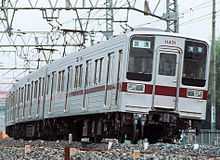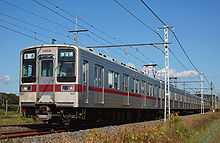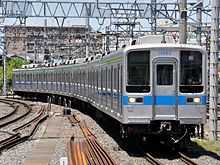Tobu 10000 series
| Tobu 10000 series | |
|---|---|
|
Tojo Line 10000 series 10-car set 11006, February 2008 | |
| In service | 1983–Present |
| Manufacturer | Alna Kōki, Fuji Heavy Industries, Tokyu Car Corporation |
| Replaced | 7300 series, 3000 series |
| Constructed | 1983–1995 |
| Refurbishment | 2007– |
| Number built | 486 vehicles |
| Formation | 2/4/6/8/10 cars per trainset |
| Operator | Tobu Railway |
| Depot(s) | Kasukabe, Nanakodai, Shinrinkōen, Shin-Tochigi |
| Line(s) served | Tobu Skytree Line, Tobu Isesaki Line, Tobu Nikko Line, Tobu Urban Park Line, Tobu Tojo Line |
| Specifications | |
| Car body construction | Stainless steel |
| Car length | 20,000 mm (65 ft 7 in) |
| Width | 2,850 mm (9 ft 4 in) |
| Doors | 4 pairs per side |
| Maximum speed | 110 km/h (70 mph) |
| Power output | 140 kW x4 per motor car |
| Acceleration | 2.5 km/h/s |
| Deceleration | 4.5 km/h/s (emergency brake) |
| Electric system(s) | 1,500 V DC |
| Current collection method | Overhead lines |
| Track gauge | 1,067 mm (3 ft 6 in) |
The Tobu 10000 series (東武10000系 Tōbu 10000-kei) is a commuter electric multiple unit (EMU) train type operated in Japan by the private railway operator Tobu Railway since 1983.
First entering service in 1983 on the Tobu Tojo Line (1984 on the Tobu Isesaki Line), production continued through to 1995, with a total of 486 vehicles built.[1]
Variants
The type was broadly divided into four sub-series, as follows.[2]
- 10000 series
- 10030 series
- 10050 series (minor variant of 10030 series)
- 10080 series
10000 series
These were built to replace the remaining 7300 series trains on the Tojo Line, with the first trains entering service from 22 December 1983.[1] 10000 series sets were also introduced on the Isesaki Line from 20 March 1984.[1]
The corrugated stainless steel body design was based on the prototype 9000 series set built in 1981, while the front end design was derived from the earlier 8000 series EMUs. The seat covers were initially brown ("Colorado orange"), but later changed to the standard light green colour used on sets built from 1986.[1]
Sets are configured as 2-, 6-, 8-, and 10-car sets. The four 10-car sets (11003 to 11006) used on the Tojo Line were formed in 1989 by adding two newly built intermediate cars to 8-car sets 11803 to 11806.[1]
Two 2-car sets (11201 and 11202) were transferred to the Tojo Line in May 2008 to augment the two remaining 8-car sets following the decision to run only 10-car formations on the Tojo Line from the start of the June 2008 timetable.
| Year built | Set numbers | External features | Internal features |
|---|---|---|---|
| 1983 | 11201 11601-2 11801-2 |
||
| 1984 | 11202 11603-4 |
||
| 1985 | 11203-4 11803-5 |
LEDs used for bodyside indicator lamps. | |
| 1986 | 11605 11806 |
Painted running numbers instead of numberplates. | Internal doors fitted. |
| 1986 | 11606-9 | Painted running numbers instead of numberplates. | Brown floor covering (instead of green), light green seat covers. |
| 1989 | cars 15003-6 16003-6 |
Total number of vehicles built: 118
Formations
10-car sets
| Car No. | 1 | 2 | 3 | 4 | 5 | 6 | 7 | 8 | 9 | 10 |
|---|---|---|---|---|---|---|---|---|---|---|
| Designation | Tc2 | M2 | M1 | T2 | TM1 | M4 | T1 | M2 | M1 | Tc1 |
| Numbering | 10000 | 19000 | 18000 | 17000 | 16000 | 15000 | 14000 | 13000 | 12000 | 11000 |
The M1 and M4 cars are each fitted with two scissors type pantographs.[3]
8-car sets
| Designation | Tc1 | M1 | M2 | T1 | T2 | M1 | M2 | Tc2 |
|---|---|---|---|---|---|---|---|---|
| Numbering | 11800 | 12800 | 13800 | 14800 | 15800 | 16800 | 17800 | 18800 |
The M1 cars are each fitted with two scissors type pantographs.[3]
6-car sets
| Designation | Tc1 | M1 | M2 | T3 | M3 | Tc2 |
|---|---|---|---|---|---|---|
| Numbering | 11600 | 12600 | 13600 | 14600 | 15600 | 16600 |
The M1 and M3 cars were originally fitted with two scissors type pantographs, but these were replaced by two single-arm pantographs on the M1 cars and one single-arm pantograph on the M3 cars after refurbishment.[3]
2-car sets
| Designation | Mc | Tc3 |
|---|---|---|
| Numbering | 11200 | 12200 |
The Mc cars are fitted with two scissors type pantographs.[3]
Refurbishment
From 2007, Isesaki Line 10000 series sets began receiving life extension refurbishment similar to that applied to the 9000 series EMUs. This involved new interiors with sculpted seats and dark blue moquette, and the addition of front-end skirts, single-arm pantographs, high-intensity headlights, and full-colour LED destination indicators.[2]
-
Interior of refurbished set, July 2010
10030 series


The 10030 subseries featured a new lightweight stainless steel body design, with a reduced number of bodyside corrugations and dull finish. A new bolsterless bogie was used. Internally, seat width was increased from 425 mm to 450 mm.[1]
Two 10-car sets (11031 and 11032) were introduced in 1989 on the Tojo Line, the first time fixed 10-car sets had been used on Tobu overground trains.[1]
| Year built | Set numbers | External features | Internal features |
|---|---|---|---|
| 1987 | 11431-2 | ||
| 1988 | 11433-4 11631-3 |
||
| 1989 | 11435-8 11634 11031-2 |
Aluminium honeycomb construction used for doors | |
| 1990 | 11439-43 11635-9 |
Radio receiver fitted. | |
| 1991 | 11444-48 11640-4 |
Grab handles increased and changed from circular to triangular. |
Total number of vehicles built: 176
Formations
10-car sets
| Car No. | 1 | 2 | 3 | 4 | 5 | 6 | 7 | 8 | 9 | 10 |
|---|---|---|---|---|---|---|---|---|---|---|
| Designation | Tc2 | M2 | M1 | T2 | TM1 | M4 | T1 | M2 | M1 | Tc1 |
| Numbering | 10030 | 19030 | 18030 | 17030 | 16030 | 15030 | 14030 | 13030 | 12030 | 11030 |
The M1 and M4 cars are each fitted with two scissors type pantographs.[4]
Some former 4- and 6-car sets have been modified as permanently coupled 10-car sets for use on the Tojo Line.[4]
| Car No. | 1 | 2 | 3 | 4 | 5 | 6 | 7 | 8 | 9 | 10 |
|---|---|---|---|---|---|---|---|---|---|---|
| Designation | Tc2 | M2 | M1 | T | T | M3 | T3 | M2 | M1 | Tc1 |
| Numbering | 14430 | 13430 | 12430 | 11430 | 16630 | 15630 | 14630 | 13630 | 12630 | 11630 |
The M1 and M3 cars are each fitted with two scissors type pantographs.[4]
6-car sets
| Car No. | 5 | 6 | 7 | 8 | 9 | 10 |
|---|---|---|---|---|---|---|
| Designation | Tc2 | M3 | T3 | M2 | M1 | Tc1 |
| Numbering | 16630 | 15630 | 14630 | 13630 | 12630 | 11630 |
The M1 and M3 cars are each fitted with two scissors type pantographs.[4]
4-car sets
| Car No. | 1 | 2 | 3 | 4 |
|---|---|---|---|---|
| Designation | Tc2 | M2 | M1 | Tc1 |
| Numbering | 14430 | 13430 | 12430 | 11430 |
The M1 cars are fitted with two scissors type pantographs.[4]
Interior
-
Interior view of a Tojo Line 11030 series set, February 2012
-
Bench seating in a Tojo Line 11030 series set, February 2012
-
Priority seating in a Tojo Line 11030 series set, February 2012
Refurbishment
Isesaki Line 10030 series sets began receiving life extension refurbishment from 2011, with the first set returned to service in March 2011. Refurbishment involves new interiors, and the addition of front-end skirts, high-intensity headlights, and full-colour LED destination indicators.[5]
The first refurbished pair of Tojo Line 10030 series sets, 6-car set 11641 and 4-car set 11445, entered service on 1 February 2012.[6] The refurbished Tojo Line 4- and 6-car sets are formed as permanently coupled 10-car sets with the equipment removed from the former inner driving cabs (former KuHa 11400 and KuHa 16600 cars becoming SaHa 11400 and SaHa 16600).[7]
-
Interior view of a refurbished Tojo Line 10030 series set, February 2012
-
New sculpted bench seating in a refurbished Tojo Line 10030 series set, February 2012
-
Priority seating in a refurbished Tojo Line 10030 series set, February 2012
-
Wheelchair space in a refurbished Tojo Line 10030 series set, February 2012
-
LED passenger information display inside a refurbished Tojo Line 10030 series set, February 2012
-
LCD passenger information display inside refurbished Tojo Line 10030 series set 11640, February 2014
10050 series


This sub-series was built from 1992 to replace non-air-conditioned 3000 series trains. The design incorporated a number of further minor changes to the previous 10030 series design.[1]
| Year built | Set numbers | External features | Internal features |
|---|---|---|---|
| 1992 | 11251-5 11451-2 11651-7 |
Inclusion of wheelchair spaces. | |
| 1993 | 11453-4 11658-60 |
||
| 1994 | 11256-62 11455-6 11661-4 |
||
| 1995 | 11263-4 11457-8 11665 |
Ventilator units removed. Single-arm pantograph (Set 11267 only) |
Total number of vehicles built: 188
Formations
6-car sets
| Designation | Tc1 | M1 | M2 | T3 | M3 | Tc2 |
|---|---|---|---|---|---|---|
| Numbering | 11650 | 12650 | 13650 | 14650 | 15650 | 16650 |
The M1 and M3 cars are each fitted with two scissors type pantographs.[3]
4-car sets
| Designation | Tc1 | M1 | M2 | Tc2 |
|---|---|---|---|---|
| Numbering | 11450 | 12450 | 13450 | 14450 |
The M1 cars are fitted with two scissors type pantographs.[3]
2-car sets
| Designation | Mc | Tc3 |
|---|---|---|
| Numbering | 11250 | 12250 |
The Mc cars are fitted with two scissors type pantographs (single-arm type on set 11267).[3]
10080 series
Identical in outward appearance to other 10030 series sets, one 4-car set (11480) was built in 1988 to test VVVF control equipment, which was subsequently used on the 100 series Spacia EMUs and later commuter EMU types.[1]
Car 11480 of this set was experimentally repainted at Kasukabe depot for evaluation with blue/white/light blue stripes to match the colour scheme applied to the 8000 series sets, but this colour scheme was ultimately not used.[1]
Formation
| Designation | Tc1 | M1 | M2 | Tc2 |
|---|---|---|---|---|
| Numbering | 11480 | 12480 | 13480 | 14480 |
The M1 cars are fitted with two scissors type pantographs.[3]
References
- ↑ 1.0 1.1 1.2 1.3 1.4 1.5 1.6 1.7 1.8 1.9 "2006東武鉄道通勤車両カタログ" [2006 Tōbu Railway Commuter Rolling Stock Catalogue]. Tetsudō Daiya Jōhō Magazine (Kōtsū Shimbun) 35 (263): p.21–26. March 2006.
- ↑ 2.0 2.1 私鉄車両年鑑2012 [Japan Private Railways Annual 2012]. Tokyo, Japan: Ikaros Publications Ltd. February 2012. p. 158. ISBN 978-4-86320-549-9.
- ↑ 3.0 3.1 3.2 3.3 3.4 3.5 3.6 3.7 私鉄車両編成表 2010 [Private Railway Rolling Stock Formations - 2010]. Japan: Kotsu Shimbunsha. August 2010. pp. 36–40. ISBN 978-4-330-15310-0.
- ↑ 4.0 4.1 4.2 4.3 4.4 私鉄車両編成表 2012 [Private Railway Rolling Stock Formations - 2012]. Japan: Kotsu Shimbunsha. July 2012. p. 48. ISBN 978-4-330-29911-2.
- ↑ 東武10030系リニューアル車が営業運転を開始 [Tobu 10030 series refurbished set enter service]. Japan Railfan Magazine Online (in Japanese). Japan: Koyusha Co., Ltd. 8 March 2011. Retrieved 8 March 2011.
- ↑ 東武東上線で10030系リニューアル車が営業運転を開始 [Refurbished 10030 series sets enter service on Tobu Tojo Line]. Japan Railfan Magazine Online (in Japanese). Japan: Koyusha Co., Ltd. 2 February 2012. Retrieved 2 February 2012.
- ↑ "私鉄車両のうごき" [Private Rail Rolling Stock Changes]. Tetsudō Daiya Jōhō Magazine (Japan: Kōtsū Shimbun) 41 (339): p.125. 2012.
External links
| Wikimedia Commons has media related to Tobu 10000 series. |
- Tobu 10000 series (Japanese)
| ||||||||||||||||










